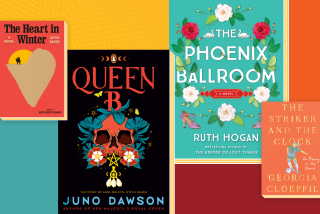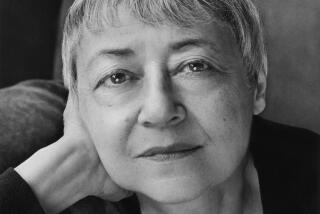Review: In Mona Awadâs âBunny,â squad goals include Pinkberry, creative writing and murder
âWe call them Bunnies because that is what they call each other,â explains Samantha Heather Mackey, the narrator of Mona Awadâs new novel, âBunny.â âSeriously. Bunny. ⌠Bunny, I love you. I love you, Bunny.â
Awad does so many things right in âBunny,â her follow-up to her 2016 debut novel, â13 Ways of Looking at a Fat Girl.â âBunnyâ functions perfectly as both a dark academic satire and a creepy horror novel, and Awad threads them both seamlessly â she can make the reader laugh out loud in one paragraph, and cringe with fear in the next.
The young women are scarily believable contradictions â theyâre ... literary riot grrrls with a cuddlecore aesthetic.
— Michael Schaub
Samantha, a student in a creative writing graduate program at a prestigious New England university, finds her simpering classmates intolerable, and with good reason. The coterie of four young women have made an art form out of platonic and public displays of affection: âHow fiercely they gripped each otherâs pink-and-white bodies, forming a hot little circle of rib-crushing love and understanding it took my breath away. ⌠All four of their glossy mouths making squealing sounds of monstrous love that hurt my face.â
The Bunniesâ performative friendship rankles Samantha to no end, and she complains about them to her best friend, Ava, a semi-Goth cynic who also canât abide the stubbornly twee clique, and to Jonah, a sweet young poet and recovering alcoholic who has taken a shine to Samantha.
Samantha senses that her dislike of the Bunnies is mutual, noting how her workshop classmates âwould look down at each story I submitted like it was a baby that just gave them the finger, and then side-eye each other for a long time.â
So sheâs shocked when the Bunnies invite her to a âSmut Salon,â a mysterious gathering to be held at one of their houses. Samanthaâs morbid curiosity gets the best of her, and despite Avaâs wariness about the young women, she decides to show up.
The experience isnât as bad as she feared and Samantha wonders whether sheâs got her classmates all wrong. So she attends the next one. And thatâs when things start to go wrong. Without giving too much away, thereâs a fake prom that ends with someoneâs head exploding, which tends to put a damper on even the most well-organized formal dance. Then things get even weirder.
The chapters that follow find Samantha in the thrall of the Bunnies, helping them conduct some truly alarming experiments involving (actual) bunnies, and eating lunch at a cutesy restaurant that only serves miniature foods. It doesnât take long for things to get out of hand, and the novel culminates in a shocking and bizarre confrontation that you truly have to read to believe.
With the Bunnies, Awad has created some of the most memorable antagonists in recent fiction. The young women are scarily believable contradictions â theyâre fans of both transgressive, experimental prose and Pinkberry frozen yogurt, literary riot grrrls with a cuddlecore aesthetic. They love-bomb Samantha one minute and tear her down the next, angering Ava, who hates their âlittle-girl cult.â
Theyâre also perfect foils for Awadâs satire of the preciousness and navel-gazing that sometimes accompany discourse about creative writing. The Bunnies try to get Samantha to collaborate with them on a project that they variously describe as âexperimental,â âperformance basedâ and âso intertextual,â eventually settling on âa hybrid.â (âThat most obscure of academic beasts,â Samantha thinks. âWhat you call something when you just donât know what youâre doing anymore.â) The scenes in which Samantha and her classmates discuss their respective projects will be darkly familiar to anyone whoâs had to endure a creative writing workshop filled with gleefully pretentious would-be auteurs.
Awad is masterful at conjuring prose thatâs both darkly atmospheric and creepily evocative.
— Michael Schaub
Awad has a true gift for satire â âBunnyâ is as mercilessly funny as similarly themed novels by Jane Smiley (âMooâ) and James Hynes (âThe Lecturerâs Taleâ). But it also shines as a horror tale. The contrast between the Bunniesâ âMy Little Ponyâ-inflected sensibilities and the horrifying nature of their, uh, âprojectsâ proves chillingly effective; Awad is masterful at conjuring prose thatâs both darkly atmospheric and creepily evocative. She also knows how to use pacing to build suspense â âBunnyâ is just about as hard to put down as any book thatâs come around in a while.
Itâs a novel thatâs difficult to describe but easy to fall in love with. Awad has created a singular world, inspired just as much by the dark fairy tales of the Brothers Grimm as it is by the cult-classic movie âHeathersâ (which Awad makes several sneaky allusions to throughout the book). With her second book, Awad has proved herself one of the most innovative and original authors out there, and âBunnyâ is a wild, audacious and ultimately unforgettable novel.
::
Mona Awad
Viking, 320 pp., $26
Schaub is a writer in Texas.
More to Read
Sign up for our Book Club newsletter
Get the latest news, events and more from the Los Angeles Times Book Club, and help us get L.A. reading and talking.
You may occasionally receive promotional content from the Los Angeles Times.







